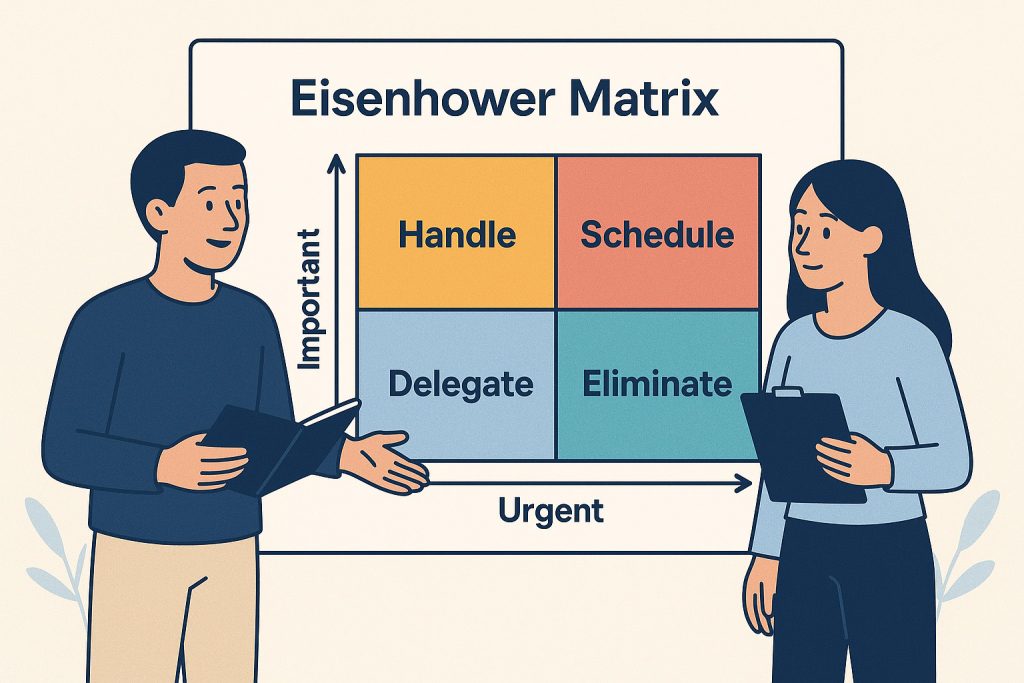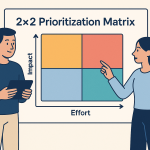What is the Eisenhower Matrix?
When your phone buzzes with notifications while you’re drowning in emails, racing toward deadlines, and juggling personal commitments, the question isn’t whether you’re busy—it’s whether you’re focusing on what actually moves the needle. The Eisenhower Matrix cuts through this modern chaos with surgical precision, offering a framework that separates the truly significant from the merely loud.
At its core, this decision-making tool operates on a fundamental insight: not all tasks are created equal. By plotting your responsibilities on two simple axes—how urgent they feel versus how much they actually matter—the matrix reveals patterns in how you spend your time that might surprise you. The framework creates four distinct zones, each requiring a completely different approach to maximize your effectiveness.
Think of it as a GPS for your attention. Instead of wandering aimlessly through your to-do list, you gain a clear roadmap showing exactly where your energy should go first, what deserves your future attention, what you should hand off to others, and what you should abandon entirely.
What’s the History of the Eisenhower Matrix?
The genesis of this framework traces back to someone who faced impossible choices daily under the highest possible stakes. While commanding Allied forces in World War II, Eisenhower couldn’t afford to waste mental energy on the wrong priorities—lives literally hung in the balance of his decision-making. Later, as President during the Cold War’s most tense moments, he refined this approach into a systematic method for cutting through complexity.
What makes Eisenhower’s contribution remarkable isn’t just the framework itself, but the context from which it emerged. This wasn’t born in a business school classroom or productivity blog—it developed in war rooms and the Oval Office, where the cost of poor prioritization could reshape history.
The framework might have remained a footnote in presidential memoirs if not for Stephen Covey’s recognition of its broader applicability. When Covey featured it in his bestselling work on effectiveness, he translated military-grade decision-making into principles anyone could apply. The timing proved perfect—as work became more complex and distractions multiplied, people desperately needed a reliable method for separating signal from noise.
How Do You Use the Eisenhower Matrix?
Building your matrix starts with brutal honesty about your current reality. Most people discover they’ve been unconsciously prioritizing urgency over importance, creating a reactive cycle that keeps them perpetually behind. The framework breaks this pattern by forcing conscious choice about where attention goes.
The Four Decision Categories:
- Crisis Management Zone: Handle these immediately—they’re both pressing and significant
- Strategic Investment Zone: Schedule these carefully—they build long-term value but rarely demand attention
- Distraction Trap Zone: Delegate these quickly—they feel urgent but don’t require your specific expertise
- Time Sink Zone: Eliminate these entirely—they neither help nor demand immediate action
The real power emerges when you start moving tasks between categories. That “urgent” email from a colleague might actually belong in the delegation zone. The strategic planning session you keep postponing represents an investment opportunity, not just another meeting. The social media check that somehow stretches into an hour clearly belongs in the elimination category.
Implementation Strategy:
- Morning Audit: Categorize your day’s tasks before diving into work
- Weekly Review: Assess whether you’re spending enough time in the strategic zone
- Monthly Reflection: Identify patterns in what keeps pulling you toward reactive work
- Quarterly Reset: Adjust your approach based on what you’ve learned about your tendencies
The matrix works best when it becomes a lens for viewing all your commitments, not just a one-time sorting exercise. Each task you encounter gets filtered through these four categories, creating automatic decision-making that saves mental energy for what actually matters.
Eisenhower Matrix for Time Management
Traditional time management focuses on efficiency—doing things faster. The Eisenhower Matrix prioritizes effectiveness—doing the right things entirely. This distinction becomes crucial when you realize that optimizing the wrong activities simply wastes time more efficiently.
The framework reveals uncomfortable truths about modern work patterns. Most professionals spend 60-70% of their time in reactive mode, constantly responding to other people’s priorities rather than advancing their own objectives. The matrix doesn’t just identify this pattern—it provides a systematic escape route.
Time Allocation Insights:
- Crisis Prevention: Strategic investments prevent 80% of future emergencies
- Delegation Multiplier: Every task you delegate creates time for higher-value activities
- Elimination Benefits: Cutting low-value activities often improves performance more than optimizing important ones
- Energy Management: Different quadrants require different mental resources—plan accordingly
The most counterintuitive discovery is that spending more time in the “important but not urgent” zone actually reduces the number of genuine crises you face. When you invest in prevention, planning, and development before problems become critical, you break the reactive cycle that keeps most people perpetually stressed.
Consider how this plays out practically: spending thirty minutes weekly on relationship maintenance prevents hours of damage control later. Investing in skill development creates opportunities that eliminate entire categories of problems. Building systems proactively removes dozens of small decisions from your daily load.
Eisenhower Matrix Examples
The matrix’s versatility becomes apparent when applied across different roles and contexts. While the specific tasks vary dramatically, the underlying patterns remain remarkably consistent—most people underinvest in strategic activities while overreacting to false urgencies.
Product Owner
Product owners live at the intersection of competing demands—developers need direction, stakeholders want updates, and customers expect results. The matrix helps them maintain strategic focus while staying responsive to genuine needs.
Crisis Management Focus:
- Production bugs affecting user experience
- Blocked developers waiting for critical decisions
- Stakeholder escalations requiring immediate clarification
Strategic Investment Priorities:
- User research to inform future development
- Competitive analysis for strategic positioning
- Team capability building and mentoring
Smart Delegation Opportunities:
- Routine status updates to various stakeholders
- Documentation creation and maintenance
- Cross-team coordination for standard processes
Clear Elimination Targets:
- Excessive meeting attendance without clear contribution
- Detailed involvement in technical implementation decisions
- Administrative tasks that don’t require product expertise
Project Manager
Project managers orchestrate complex initiatives while avoiding becoming bottlenecks themselves. The matrix helps them focus on activities that truly require their coordination skills while empowering others to handle routine tasks.
Immediate Action Required:
- Resource conflicts threatening project timelines
- Scope changes requiring stakeholder alignment
- Risk mitigation for high-probability threats
Long-term Value Creation:
- Process improvement based on lessons learned
- Team development and cross-training initiatives
- Stakeholder relationship building for future projects
Delegation Candidates:
- Routine progress reporting and status updates
- Meeting facilitation for standard check-ins
- Research tasks that don’t require project context
Time Wasters to Eliminate:
- Involvement in technical decisions outside their expertise
- Micromanaging team members on routine deliverables
- Attending meetings where they’re not contributing value
Director of Product
Senior product leaders must balance strategic oversight with operational involvement. The matrix helps them maintain the right altitude—high enough for strategic perspective, low enough for meaningful impact.
Strategic Imperatives:
- Vision alignment across multiple product lines
- Critical customer relationships requiring executive attention
- Board-level communication and organizational updates
Investment Opportunities:
- Talent development and succession planning
- Market research and competitive intelligence
- Cross-functional relationship building with sales and marketing
Delegation Essentials:
- Tactical product decisions within established parameters
- Routine customer feedback synthesis and analysis
- Operational metrics reporting and dashboard maintenance
Clear Boundaries:
- Day-to-day feature prioritization decisions
- Individual team member performance management
- Technical architecture discussions below strategic level
Try the Eisenhower Matrix for Yourself
The matrix’s true test comes not in understanding its logic but in consistently applying it when pressure mounts and old habits resurface. Most people intellectually grasp the framework immediately—the challenge lies in rewiring deeply ingrained response patterns that prioritize urgency over importance.
Start by tracking your current patterns for a week without changing anything. Simply categorize each significant task or interruption into one of the four quadrants. This awareness exercise often proves more valuable than any productivity technique because it reveals the gap between intention and reality. You might discover you’re spending 70% of your time on other people’s priorities while your most important objectives languish in the “someday” category.
The framework becomes truly powerful when it shifts from a sorting tool to a decision filter. Before accepting new commitments, ask which quadrant they belong in and whether they align with your current capacity in each zone. Before responding to interruptions, pause to categorize them—is this genuinely urgent and important, or just loud and persistent?
Remember that mastering the matrix isn’t about perfect categorization or rigid adherence to rules. It’s about developing better instincts for where to invest your finite attention and energy. Some days will still feel chaotic, but you’ll navigate that chaos with greater intentionality and less regret about time spent on activities that didn’t ultimately matter.


